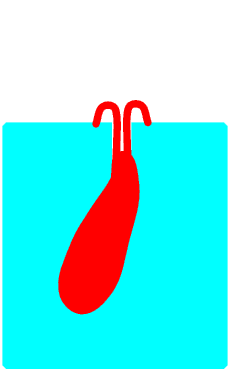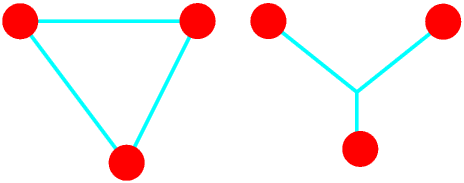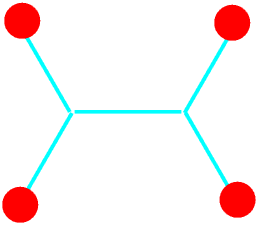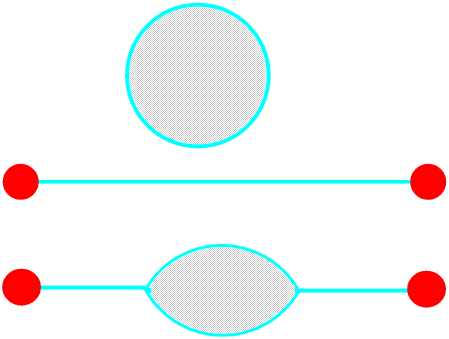
A personal note to adults who attended the Bubbles Afternoon at Gillingham United Reformed Church on Wednesday 15th August 2018.
I started building this Web Site in September 1996 although it has of course been very much expanded and changed since then. The Target Readership of my Maths and Science Pages is students working towards English school leaving exams at 16+, although I know from my e-mails from all over the world that many adults and younger children also find them interesting and helpful. I get about 30 000 visitors a month, and more than 80% of those who stay for longer than 30 seconds stay for longer than five minutes.
The Surface Tension Page has been very much expanded during the weeks preceding our Bubbles Afternoon; I would be very grateful if you have any photographs taken at this event which you think might make it more interesting or helpful and would be willing to allow me to include them on this Web Page.
Here is a jar of water from the cold tap.

Water consists of millions and millions of very tiny particles, called molecules. Each molecule of water consists of two atoms of hydrogen joined with one atom of oxygen, or H2O.
Atoms are unimaginably tiny. When we walk over a sandy beach with bare feet after we have been swimming in the sea grains of sand will stick to our feet. Sand is mainly silicon dioxide, a molecule of silicon dioxide is one atom of silicon joined with two atoms of oxygen or SiO2. Sand also contains small quantities of other substances, which is why not all sands are the same colour. If we cover a football (soccer) pitch with a layer of sand deep enough to cover the goal posts, there are more atoms in one grain of sand than there are grains of sand on the football pitch!
All the molecules of water are attracting each other. In the middle of the beaker the molecules are attracted in every direction, but at the surface, where the water meets the air, they are being attracted sideways and downwards but not upwards, so they behave differently: it is as though the molecules at the surface of the water are part of a very tightly stretched skin, a bit like a balloon. This effect is called surface tension.
Surface tension is always trying to pull the liquid into the shape with the smallest possible surface area - for a droplet of water, or any other liquid, this is usually a sphere. In the Old Days lead shot for muskets and other guns was made in a Shot Tower. This was a tall hollow tower. Molten lead was poured from a cauldron at the top, and as the liquid lead fell down inside the tower it broke up into droplets which surface tension pulled into a sphere. These started to solidify before they reached the bottom. At the bottom they fell into a tub of water. The pellets were all spherical but not all the same size, so they were then passed through different sized sieves to sort them into the right sizes for the different types of gun.
Surface tension exists in all liquids but it is different for different liquids, and the rest of this Page is only about water.
For this experiment you will need a bowl of clean tap water, a sewing needle (care - pointy!) and a paper tissue or a piece of kitchen roll. (And a drop of washing up liquid, but only at the very end.)
Put the piece of paper on the surface of the water and then very carefully, using dry hands, put the needle onto the paper. The paper will soak up the water and will soon sink to the bottom of the water, but the needle does not break the surface film so floats on it! (If the paper takes more than about twenty seconds to sink you can push one edge of the paper down with something like the handle of a spoon but not your fingers.) If you look very carefully you can see the dent the needle makes in the water, like pushing your finger into a balloon. If you have magnetised the needle first you can use it as a simple compass - how to do this is described on another Page.
Some small insects and small animals can walk on water in this way - a web search on pond skaters will produce lots of lovely pictures.
Many animals including fishes and dragonfly larvae and tadpoles live in water, and these get the oxygen they need to live from the oxygen dissolved in the water. If the water loses its oxygen (becomes eutrophied) they will die - how this can happen is described here. (Whales and dolphins are mammals, so although they live in water they have to come to the surface to breathe air.) Mosquito larvae also live in water but they breathe air through a narrow tube in their tails by using the surface tension of the water to hang from them! So they can live in water too polluted for anything else to live, particularly animals such as fishes which might eat them!

Once you have watched the needle floating for long enough and shown all your family how clever you are you can end the experiment in a spectacular way which explains soap bubbles!
Put one drop of undiluted washing up liquid onto a small plate, then touch this drop with something like the handle of a teaspoon, then touch this part of the teaspoon to the surface of the water in the bowl, well away from where the needle is floating. The needle will sink instantly!
Water with soap (or other detergent) in it has a much lower surface tension than clean water, and this affects the way it behaves when it comes into contact with something like our skin or our hair or our clothes or our dirty dishes, which is of course why we use soap for washing our skin, our hair, our clothes and our dirty dishes. It is the much lower surface tension of soap solution which makes soap films and soap bubbles possible.
Soap bubbles can float away on the wind, and if they come into contact with a tent they will have the same effect on the tent fabric that they have your clothes, that is, make it less waterproof, so you should not make bubbles on a camping site.
Ducks (real and plastic), and you, and aircraft carriers, are much too heavy not to break the surface tension film: we can float in water because of our buoyancy not because of surface tension.
Before you do anything else take the needle out of the bowl and dry it and put it away safely, unless you are going to use it again straight away when you should put a piece of BluTack® or similar on the point to make it safe.
You can make a ”bubble mixture” for making bubbles and soap films in many ways, and the cheapest and easiest is by mixing ordinary washing up liquid with tap water, but if you want really big bubbles and soap films and want them to last a long time it is better to use a proper bubble mixture. You can buy bubble toys and these usually come with a small supply of ready-mixed solution, and you can also buy refills in various sizes. For the very best results you should buy a special concentrated liquid and mix it with rain water or, in school, distilled or deionised water. For the photos on this Page I used Dr Zig’s Bubble Mix but mixed it with tap water.
Always remove any froth or foam from the surface of the mixture before using it, a paper tissue is useful for this. Foams and froths are described later.
Here we have a soap film inside a solid frame such as a metal ring.

The surface tension in the soap film is very weak, nowhere near strong enough to pull the liquid away from the frame and into a spherical droplet, but the soap film will always have the smallest possible surface area.
If we take away the frame the soap film will either burst or form itself into a spherical air-filled bubble: a soap film or bubble must always have two surfaces with the air but they must never touch.

The frame does not have to be round, or even flat: try bending a metal wire clothes hanger into a really twisty shape and then putting it into the bubble mixture.. Rumour has it that the spectacular roof of the Sydney Opera House was designed in this way!
If you want to study the wonderful colours you can see in a soap film this is the best way to make it - see below.
If we have three wires two arrangements of soap films are possible.

Three, but never more than three, soap films can meet, and the angle between them where they meet is always 120°, but the films do not have to be flat.
With four wires we might get an arrangement like this. Your School might have a soap film kit allowing you to do experiments like these for yourself.

A soap film cannot move away from its frame, but a bubble follows the air currents. If it hits another bubble or soap film it will usually join with it.

Remember that the angles between soap films are always 120°
If a bubble hits a solid object it may just stick to it, or it may burst, or, and most people find this surprising, it may bounce off: you can buy special bats like table tennis bats to play games with bubbles!
A soap film or bubble will burst if it is damaged, just like a balloon. But they are quite stretchy so they can change their shape without bursting, again just like a balloon.
If you blow on a soap film you will change its shape and it may then either break away from its frame and become a bubble or burst. But most soap films and bubbles burst and come to an end because the water in them is evaporating.
Gravity is acting on the liquid in the soap film, so it is thinnest at the top and thickest at the bottom. Only surface tension is keeping all the molecules together. The water is evaporating, and eventually the film will be too thin for the surface tension to hold it together and it will break, always at the top of course. At this point the surface tension will pull the water into thousands of very tiny droplets, far too small to see. If it bursts on a surface such as your clothes it will leave a slightly damp patch, otherwise the water droplets will all very quickly evaporate.
If you have several soap films and bubbles joined together they will not all burst at the same time: as each one bursts the surface tension in the others pulls them into different shapes. Bubbles usually last longer than soap films because in a soap film the water is evaporating at the same rate from both sides whereas for a bubble the water is evaporating more slowly from the inside surface than the outside. So if you start with a “square” bubble inside a cube you will end up with a spherical bubble by itself! (It might float away or it might stick to a part of the frame.)
If we stir or shake soapy water we may get lots of very tiny bubbles all joined together - this is called a foam or a froth. This takes a long time to disappear because the inside bubbles are protected from the air by the outside ones.
We can also get froth on, for example, beer or milk - both do contain water of course. Many adults do not like foam on their beer, but many children like frothy milk.
The bubbles in fizzy drinks contain carbon dioxide. They may form anywhere in the liquid but once formed they always float straight to the top. The surface tension of the water pulls them into a spherical shape, but they burst as soon as they reach the surface and do not form a foam or froth.
Even without adding soap or anything else, water that is being really churned up and mixed with the air, for example at the bottom of a high waterfall or where waves are breaking on the seashore, may also have foam on it, although it does not last long.
If you just want to have fun with bubbles foam and froth are a nuisance, but they do have their uses, for example in putting out or preventing fires involving burning liquids after an aircraft has crashed and damaged its fuel tanks.
The reason why we get colours in bubbles and soap films is necessarily slightly more technical and is given on another Page (currently under construction - come back in about a week).
© Barry Gray August 2018